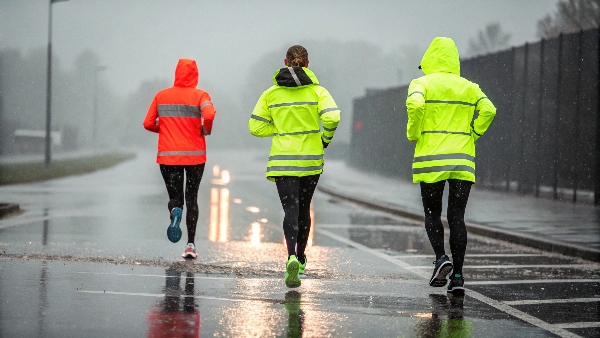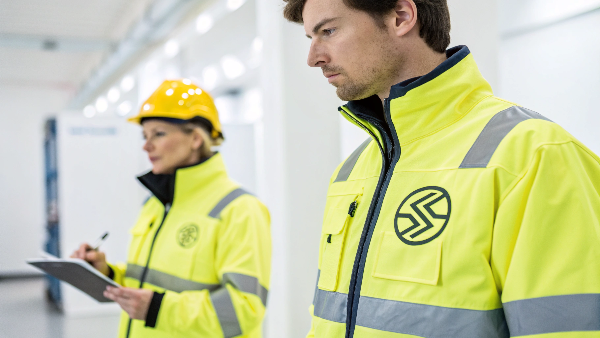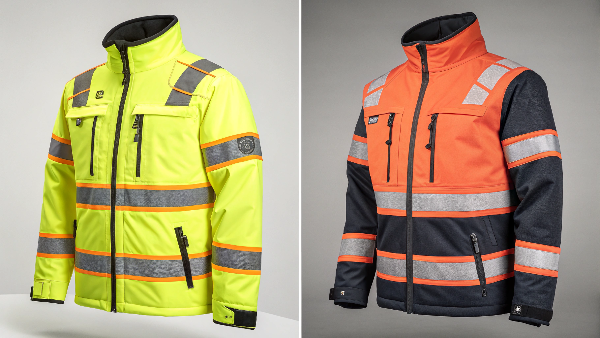Road work or walking near traffic can be dangerous, especially in low light. Reflective jackets make you seen, preventing accidents. This simple gear is key to your safety.
A reflective jacket significantly enhances road safety by using retro-reflective materials. These materials bounce light directly back to its source, like car headlights. This makes the wearer highly visible to drivers from a distance, especially during nighttime or poor visibility conditions, drastically reducing accident risks.
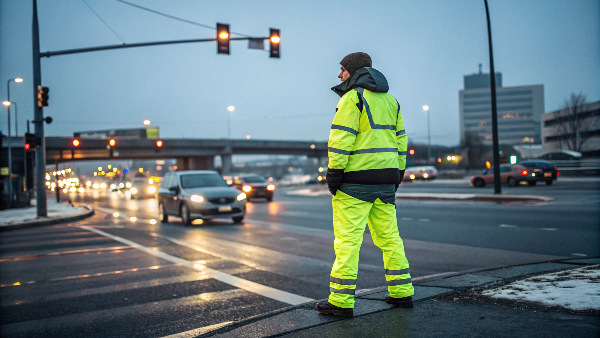
Keeping safe on or near roads is a big concern for many people. You want to be sure drivers can see you, no matter the time of day or weather. Reflective jackets are a straightforward solution. We will look into how they work and why they are so important. Let us explore the details.
What are the benefits of a reflective jacket?
Working or moving near roads in dim light is risky. A reflective jacket1 makes you stand out. This helps drivers see you easily, keeping you safer.
The primary benefit of a reflective jacket is drastically increased visibility2. This leads to fewer accidents, especially in low-light conditions. It also promotes a safer working environment for personnel on or near roadways, and can meet legal safety requirements.
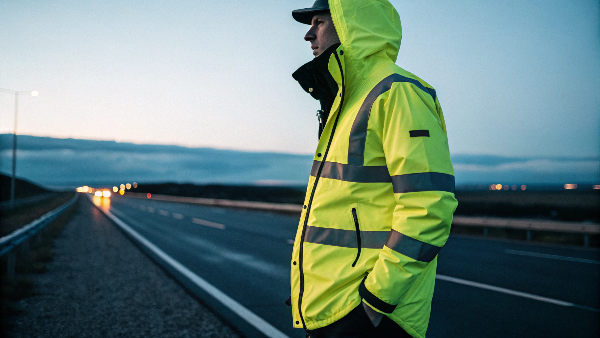
Understanding the full range of benefits helps explain why these jackets are so vital. It is not just about being seen; it is about creating a safer environment for everyone. At Vissafety, we have seen firsthand how our high-visibility clothing makes a difference. For instance, a construction crew working on a highway project told us that since they started using our EN ISO 20471 certified reflective jackets, near-miss incidents dropped significantly. This is because the bright, reflective materials catch drivers' attention much earlier.
Key Advantages Explained
Reflective jackets offer more than just basic visibility. They provide a comprehensive safety solution.
- Enhanced Conspicuity: This is the main job. The bright colors are for daytime, and the reflective strips are for nighttime.
- Accident Prevention: By making you more visible, these jackets give drivers more time to react. This is very important in fast-moving traffic or bad weather.
- Compliance with Regulations: Many jobs, like construction or road maintenance, require workers to wear certified high-visibility clothing. Our jackets meet standards like ANSI/ISEA 107 and EN ISO 20471.
- Versatility: They are not just for workers. Cyclists, pedestrians, and emergency responders all benefit.
Here is a table summarizing these benefits:
| Benefit | Description | Impact on Safety |
|---|---|---|
| Increased Visibility | Makes the wearer stand out in various light conditions. | Reduces the risk of not being seen by drivers. |
| Accident Reduction | Gives drivers more time to react, preventing potential collisions. | Fewer injuries and fatalities on roads. |
| Regulatory Compliance | Meets legal and industry safety standards for high-visibility apparel. | Ensures workplace safety and avoids legal issues. |
| Peace of Mind | Wearers feel safer knowing they are more visible to others. | Improves confidence and focus for workers. |
| Worker Morale | Providing quality safety gear shows care for employee well-being. | Can lead to better productivity and company loyalty. |
These benefits together show how a simple piece of clothing can have a big impact on safety and even on how a company operates.
What is the safety use of reflective jacket?
People often worry about safety when they are near moving vehicles. A reflective jacket is a simple tool. It helps drivers spot you quickly, which is crucial for safety.
The safety use of a reflective jacket is to make individuals highly conspicuous to vehicle operators. This is vital for road workers, emergency responders, cyclists, and pedestrians, especially during nighttime, dawn, dusk, or in adverse weather conditions like rain or fog.
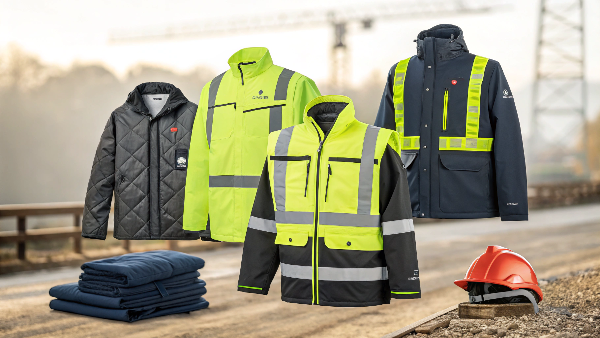
Reflective jackets are designed for one main purpose: to save lives by preventing accidents. We, as manufacturers, understand this deeply. Our mission is to provide top-quality high-visibility clothing3 that empowers safety. Think about a road construction team working at night. Without reflective jackets, they are almost invisible to fast-approaching cars. But with our Vissafety jackets, their presence is highlighted from hundreds of meters away. This early warning gives drivers plenty of time to slow down or change lanes. The use extends to many situations.
Specific Safety Applications
Reflective jackets are not just a general safety item; they are critical in specific roles and activities.
- Road Construction and Maintenance: Workers are often very close to traffic. Reflective jackets are essential here.
- Emergency Services: Police, firefighters, and paramedics need to be seen clearly at accident scenes, which are often chaotic and poorly lit.
- Logistics and Warehousing: Workers in loading docks or large yards with vehicle movement benefit greatly.
- Cycling and Pedestrians: Especially for those commuting or exercising in low light conditions.
Here is how they are used in different contexts:
| User Group | Primary Safety Use | Key Feature Utilized | Common Environment |
|---|---|---|---|
| Road Workers | To be visible to drivers while working on or near active roadways. | 360-degree reflective taping | Highways, urban streets |
| Emergency Responders | To stand out at incident scenes, often in confusing and hazardous conditions. | Bright fluorescent colors, tape | Accident sites, night calls |
| Cyclists/Motorcyclists | To be seen by motorists, especially from the sides and rear. | Reflective strips, bright color | Urban and rural roads |
| School Crossing Guards | To ensure visibility to drivers in school zones, protecting children. | Bright colors, reflective tape | School zones, intersections |
| Airport Ground Crew | To be visible to pilots and vehicle operators on busy tarmacs. | High-contrast design | Airport aprons, runways |
The core idea is always the same: make the person stand out against their background, so they are not overlooked by someone operating a vehicle or machinery. This simple function is what makes these jackets a fundamental piece of personal protective equipment (PPE)4.
Why are road reflectors important?
Ever driven at night and seen those small, bright markers on the road? They guide you. Reflective elements on jackets do the same for people, making them visible and safe.
Road reflectors, particularly those on high-visibility clothing, are important because they reflect light from vehicle headlights directly back to the driver. This creates a bright, impossible-to-miss signal, alerting drivers to a person's presence well in advance, especially in dark or poor visibility.
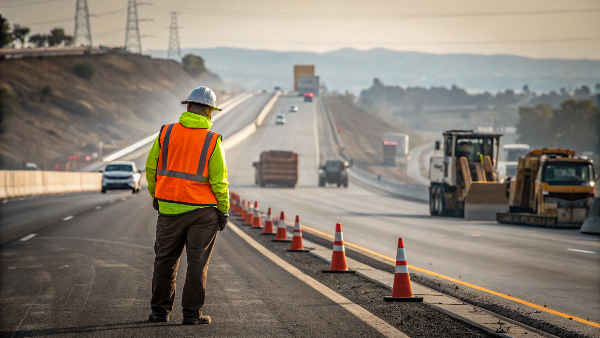
The concept of reflection is key to road safety, both for infrastructure and personal gear. While fixed road reflectors (like cat's eyes) guide vehicles along lanes, the reflectors on a jacket protect the individual human. We understand that the effectiveness of these reflectors can be a matter of life and death. That's why our Vissafety reflective tapes are designed for maximum brightness and durability, meeting global standards like EN ISO 20471 and ANSI/ISEA 107. The importance comes from how they interact with light.
The Science of Reflection for Safety
The reflectors on safety jackets are not just shiny material; they use a technology called retro-reflection5.
- Retro-reflection: Unlike a mirror that bounces light away at an angle, retro-reflective materials send light directly back towards the original source (e.g., car headlights). This means the driver gets the brightest possible return signal.
- Glass Beads or Microprisms: These are the tiny elements within the reflective tape that achieve this effect. Glass beads are small spheres, and microprisms are tiny, precisely angled corners. Both trap light and send it back.
Here's why this specific type of reflection is so crucial:
| Feature of Retro-Reflection | Why It's Important for Safety | Contrast with Normal Reflection (e.g., Mirror) |
|---|---|---|
| Direct Light Return | Ensures the driver sees the brightest reflection, as the light comes straight back to them. | Light bounces off at an angle, may not go towards the driver's eyes. |
| Wide Observation Angle | Works effectively even if the light source is not perfectly aligned with the reflective surface. | Requires precise angles for the observer to see a strong reflection. |
| Effectiveness in Low Light | Maximizes the use of available light (headlights) to make the wearer highly visible. | Less effective in low light as much of the reflected light is scattered. |
| Clear Visual Signal | The bright reflection clearly signals a human presence, distinct from other objects. | Reflections can be diffuse or blend with background light. |
The importance of these reflectors on clothing cannot be overstated. They transform a person from a dimly lit silhouette into a bright beacon, giving drivers crucial extra seconds to react. This is why we invest heavily in our R&D, with over 75 testing devices in our lab, to ensure our reflective materials are top-notch.
What is the purpose of a reflector vest?
Sometimes you need visibility without a full jacket. A reflector vest offers this. It's a lightweight way to ensure drivers see you, providing crucial safety.
The main purpose of a reflector vest is to provide high visibility for the wearer in a lightweight and less cumbersome form than a full jacket. It ensures that individuals are easily seen by vehicle operators, especially in low-light conditions or busy environments.
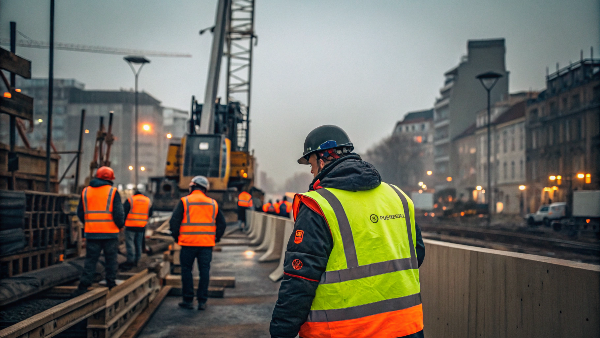
Reflector vests serve a very similar purpose to reflective jackets but offer distinct advantages in certain situations. We often recommend vests to clients who need high visibility but also require maximum freedom of movement or work in warmer climates. For example, event staff, cyclists, or warehouse workers might prefer a vest. The core purpose remains the same: to use fluorescent material and retro-reflective tape to make the wearer stand out. It’s about providing that essential layer of conspicuity.
Key Functions and Advantages
The reflector vest is a specialized piece of safety equipment designed for specific needs.
- Lightweight Visibility: Its primary function is to make the wearer visible without adding much weight or bulk.
- Enhanced Mobility: Less restrictive than a jacket, allowing for a greater range of motion.
- Use in Warmer Conditions: More comfortable to wear over regular clothing in hot weather.
- Cost-Effectiveness: Often a more budget-friendly option for achieving basic high-visibility compliance.
Consider the specific scenarios where a vest is often the preferred choice:
| Feature | Purpose/Advantage | Typical User Scenarios |
|---|---|---|
| Minimal Coverage | Provides visibility focusing on the torso, keeps wearer cool. | Summer road work, event staff, cyclists in warm weather. |
| Ease of Use | Can be quickly put on or taken off over other clothing. | Visitors to a site, temporary workers, emergency use. |
| Breathability | Mesh fabric options allow for better air circulation. | Active jobs, hot climates. |
| Affordability | Generally less expensive than full jackets. | Large-scale distribution for events, budget-conscious orgs. |
| Storage | Takes up less space, easy to store in vehicles or bags. | Emergency kits, personal carry for cycling/walking. |
While a full jacket offers more coverage and potentially more reflective surface area, the reflector vest is an indispensable tool for achieving safety through visibility in many contexts. As a manufacturer, we ensure our Vissafety vests, like our jackets, meet stringent quality and reflectivity standards, because the purpose – keeping people safe – is just as critical.
What are the benefits of reflective coating?
Reflective materials don't just appear; they are made with special coatings. This coating is what makes you shine in headlights. It’s the science behind your safety.
The benefits of reflective coating, typically using glass beads or microprismatic technology, include high brightness, durability against wear and washing, wide-angle reflectivity, and consistent performance in various weather conditions. This ensures long-lasting, reliable visibility for safety apparel.
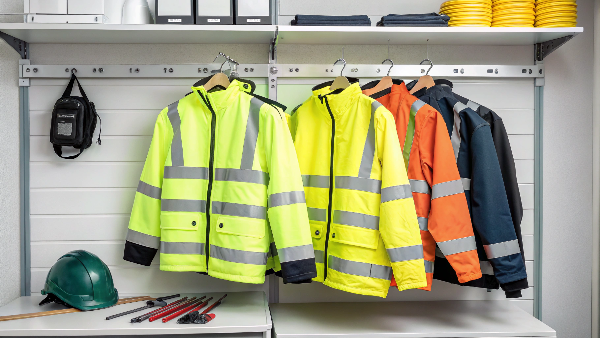
The reflective coating is the heart of any high-visibility garment. It’s not just paint; it’s a sophisticated application of materials designed to return light. At Vissafety, we focus on the quality of this coating because its performance directly impacts safety. If the coating fails, the garment loses its primary safety feature. The benefits stem from how these coatings are engineered and applied to fabrics or tapes. We ensure our coatings withstand rigorous testing for reflectivity, wash cycles, and abrasion.
Understanding Coating Technology
The technology behind reflective coatings is fascinating and crucial for their effectiveness.
- Glass Bead Technology: Tiny spherical glass beads are embedded in a binder. Light enters a bead, reflects off its back surface, and returns towards the light source.
- Microprismatic Technology: This uses tiny, precisely shaped prisms (like miniature corner reflectors). Light bounces off the internal surfaces of the prism and is directed back. Microprismatic tapes are often brighter and more durable.
Here’s a breakdown of the benefits derived from these coatings:
| Benefit of Coating | How it's Achieved | Impact on Safety Garment Performance |
|---|---|---|
| High Retro-reflectivity | Efficient light return by glass beads or microprisms. | Makes the wearer exceptionally bright when illuminated by headlights. |
| Durability | Strong binders, protective layers, quality materials. | Withstands washing, abrasion, and environmental exposure. |
| Wide Angularity | Effective reflection even when light hits from different angles. | Wearer is visible even if not directly facing the light source. |
| Weather Resistance | Materials chosen to perform in wet or varied temperature conditions. | Maintains reflectivity in rain, fog, or cold. |
| Color Options | While silver/white is common for highest reflectivity, some colors are possible. | Allows for some design flexibility while maintaining safety standards. |
| Ease of Application | Can be applied to various backing materials (fabrics, plastics). | Enables creation of diverse reflective products (tapes, heat transfers). |
For us as a manufacturer, providing garments with high-quality reflective coatings is paramount. Our clients, like Danny Cheng, rely on this for their customers' safety and to maintain their own brand reputation. A robust reflective coating means the garment will continue to perform its life-saving function for its intended lifespan. This commitment to quality is why we have triple inspections and adhere to standards like OEKO-TEX, ensuring the materials are also safe for the wearer.
What is the main purpose of wearing reflective clothing whilst riding?
Riding a bicycle or motorcycle puts you close to traffic. You are smaller than a car. Reflective clothing makes you visible, helping drivers avoid you for a safer ride.
The main purpose of wearing reflective clothing whilst riding is to significantly increase the cyclist's or motorcyclist's visibility to other road users6, especially drivers of cars and trucks. This is crucial in low-light conditions, at night, or in poor weather, to prevent accidents.
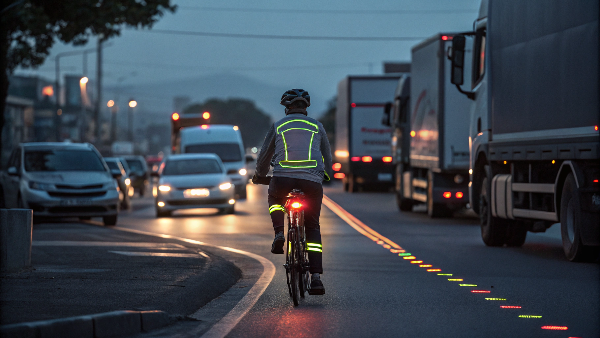
Riders, whether on bicycles or motorcycles, are among the most vulnerable road users. They lack the physical protection of a car and can be easily overlooked by drivers. We at Vissafety understand this vulnerability well. The main purpose of reflective clothing in this context is to combat this lack of conspicuity. By wearing bright, reflective gear, riders transform themselves from a hard-to-see object into a bright, unmissable presence, especially when illuminated by vehicle headlights. This buys crucial reaction time for drivers.
Why Visibility is Critical for Riders
For riders, being seen is not just an advantage; it's a fundamental safety requirement7.
- Smaller Profile: Bicycles and motorcycles are much smaller than cars and can be hidden by other vehicles or road features.
- Speed Differentials: Riders may be moving slower or faster than surrounding traffic, making judgment difficult for drivers if the rider isn't clearly visible.
- Reduced Natural Visibility: Especially at dawn, dusk, night, or in rain and fog, riders can blend into the background.
Here’s how reflective clothing addresses these issues specifically for riders:
| Challenge for Riders | How Reflective Clothing Helps | Specific Benefit |
|---|---|---|
| Being overlooked by drivers | Makes the rider stand out, especially with retro-reflective strips catching headlights. | Drastically reduces "looked but failed to see" accidents. |
| Misjudgment of distance/speed | Bright, distinct outline helps drivers better assess the rider's position and movement. | Allows drivers more accurate perception, leading to safer overtaking. |
| Poor visibility conditions | Fluorescent colors aid daytime visibility; reflective elements excel in low light/night. | Ensures the rider is seen across a wider range of lighting and weather scenarios. |
| Side-on visibility | Reflective elements on sides of clothing, or even on moving parts like ankles/wrists. | Helps drivers see riders at junctions or when rider is crossing traffic. |
| Identification as a person | Human-shaped reflective patterns (biomotion) can help drivers quickly recognize a cyclist. | Faster recognition leads to faster appropriate reactions from drivers. |
Many of our clients who distribute to cycling shops or motorcycle gear retailers emphasize the demand for EN ISO 20471 or ANSI/ISEA 107 compliant gear, even for recreational users. It underscores that the purpose is clear: reflective clothing is a rider's best tool for being seen and staying safe on the road.
Why is a safety jacket important?
Working outdoors or in hazardous areas exposes you to risks. A safety jacket does more than keep you warm. It makes you visible, protecting you from accidents.
A safety jacket is important because it provides crucial visibility to the wearer, especially in high-traffic or low-light environments, significantly reducing the risk of accidents. It often also offers protection from weather and meets regulatory safety compliance standards.

A safety jacket, particularly one with high-visibility features, is a cornerstone of personal protective equipment (PPE). Its importance stems from its primary role: to prevent accidents by making the wearer easily detectable. We at Vissafety have built our company around this principle. When someone is working near moving vehicles, heavy machinery, or in poorly lit conditions, their ability to be seen can be the difference between a safe workday and a tragic incident. The safety jacket acts as their first line of defense.
Multifaceted Importance of Safety Jackets
The importance of a safety jacket goes beyond just one single feature. It’s a combination of elements working together.
- Visibility: This is paramount. Bright fluorescent colors for daytime and retro-reflective tapes for nighttime and low-light conditions.
- Accident Prevention: By enhancing visibility, it gives others, especially vehicle operators, more time to see and react to the wearer's presence.
- Compliance and Professionalism: In many industries, wearing certified safety jackets (e.g., ANSI/ISEA 107, EN ISO 20471) is a legal requirement. It also shows a commitment to safety.
- Worker Protection: Some safety jackets also offer protection against weather (rain, wind, cold) or other workplace hazards like minor scrapes.
Let's consider the different aspects of their importance:
| Aspect of Importance | Description | Impact on Wearer/Workplace |
|---|---|---|
| Injury Prevention | Reduces likelihood of being struck by vehicles or machinery by making the wearer highly conspicuous. | Fewer workplace accidents, injuries, and fatalities. Lower insurance and compensation costs. |
| Legal Compliance | Fulfills occupational health and safety regulations requiring high-visibility clothing in certain jobs. | Avoids fines, legal liabilities, and work stoppages. |
| Enhanced Awareness | Not only makes the wearer visible but can also signal to others that they are in a potentially hazardous area. | Heightens general safety consciousness on site. |
| Environmental Protection | Some jackets offer features like waterproofing or insulation, protecting from harsh conditions. | Keeps workers comfortable and able to focus on their tasks safely. |
| Brand Image | For companies, providing quality safety gear reflects positively on their commitment to employee welfare. | Improves worker morale and can enhance company reputation. |
Danny Cheng, one of our long-term clients, always emphasizes the need for reliable, compliant safety jackets for his customers in North America. He knows that the importance of these garments lies in their consistent performance and the trust workers place in them. This is why our triple inspection process and adherence to international standards are so critical. A safety jacket is not just clothing; it's a commitment to someone's well-being.
What is the use of reflective materials for safety?
You've seen them on safety vests, road signs, and even running shoes. Reflective materials are everywhere. Their use in safety is to turn darkness into an advantage for visibility.
The use of reflective materials for safety is to make objects or people highly visible in low-light conditions when illuminated by a light source, such as vehicle headlights. They bounce light directly back to the source, alerting observers to potential hazards or individuals.
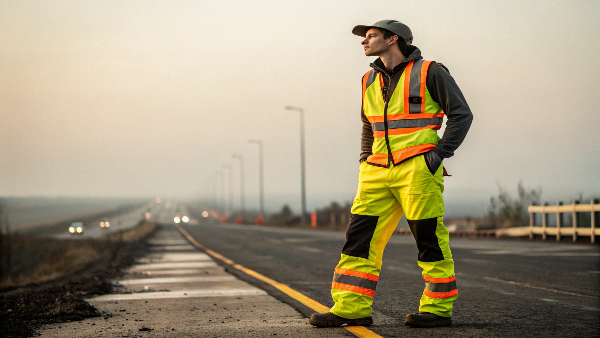
Reflective materials are a special class of materials engineered to enhance visibility and, therefore, safety. At Vissafety, these materials are the core component of our high-visibility clothing. Their primary use is to take ambient light, especially directional light like car headlights, and return it effectively, making the person wearing them stand out dramatically against a dark background. This isn't just about being shiny; it's about a specific optical property called retro-reflection. This property is what makes these materials indispensable for safety applications.
How Reflective Materials Work and Their Applications
The effectiveness of reflective materials comes from their unique ability to redirect light.
- Retro-reflection: As mentioned before, this is key. The material sends light back to its source, not scattered like ordinary surfaces.
- Types of Materials: Commonly, these are glass beads or microprismatic sheeting. Glass beads are tiny spheres, and microprisms are cube-corner reflectors, both embedded in a flexible base.
- Versatility: These materials can be applied to various surfaces – fabrics for clothing, metal for signs, plastics for barriers.
Here are some common uses and why they are effective:
| Application Area | Specific Use of Reflective Material | Safety Benefit Achieved |
|---|---|---|
| Personal Safety Wear | Strips or full fabric on vests, jackets, pants, hats, gloves, footwear. | Makes individuals (workers, cyclists, pedestrians) highly visible to vehicle operators. |
| Road Signs & Markings | Sheeting on traffic signs, lane markers, delineators, barricades. | Provides clear guidance and warnings to drivers, especially at night or in bad weather. |
| Vehicle Markings | Conspicuity tape on trucks, trailers, emergency vehicles, school buses. | Makes large or slow-moving vehicles more visible, reducing collision risks. |
| Emergency Equipment | On life rafts, survival suits, buoys, search and rescue gear. | Aids in locating people or equipment in distress, especially in dark or marine settings. |
| Recreational Gear | On backpacks, tents, pet collars, children's clothing. | Enhances visibility for safety during outdoor activities. |
The fundamental use of these materials is to leverage any available light to signal presence. In our factory, we conduct extensive tests on the reflective materials we use, checking their coefficient of retro-reflection (RA value) to ensure they meet or exceed standards like EN ISO 20471 and ANSI/ISEA 107. This guarantees that the final safety garment will perform its critical life-saving function effectively, night after night, wash after wash.
When should you wear a reflective vest?
Not sure if conditions warrant high-vis gear? A reflective vest8 is an easy choice. It's best worn whenever being seen by others, especially drivers, is critical for your safety.
You should wear a reflective vest whenever your visibility to others9, particularly vehicle operators, might be compromised. This includes nighttime, dawn/dusk, foggy or rainy weather, and when working on or near roads, construction sites, or in any area with moving vehicles/machinery.
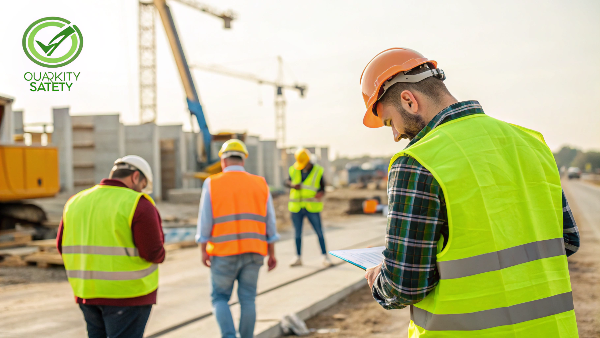
Knowing when to wear a reflective vest is just as important as having one. It’s about recognizing situations where your natural visibility is reduced, increasing the risk of accidents. As a manufacturer, we advocate for their use in a wide array of scenarios because we've seen their life-saving impact. The general rule is: if there's a chance you might not be easily seen by someone operating a vehicle or machinery, put on a reflective vest. This simple action can dramatically increase your safety margin.
Key Situations Requiring a Reflective Vest
Certain conditions and activities inherently call for the enhanced visibility a reflective vest provides.
- Low Light Conditions: This includes nighttime, but also crucial periods like dawn and dusk when light is changing and drivers' eyes are still adjusting.
- Adverse Weather: Rain, fog, snow, or even heavy overcast conditions significantly reduce visibility.
- Proximity to Traffic: Any work or activity on or near roads, highways, or parking lots.
- Complex Visual Environments: Busy construction sites or industrial areas where many things compete for attention.
Here’s a table outlining specific times and situations:
| Condition/Activity | Why a Reflective Vest is Needed | Who Typically Wears It |
|---|---|---|
| Nighttime Operations | Natural visibility is extremely low. | Road workers, emergency responders, security personnel, cyclists, pedestrians. |
| Dawn and Dusk | Changing light levels make it hard for drivers to spot pedestrians/workers. | Commuters (cycling/walking), joggers, construction workers starting/ending shifts. |
| Inclement Weather (Rain, Fog, Snow) | Visibility is severely impaired for drivers. | Anyone outdoors, especially near traffic or machinery. |
| Roadside Work/Emergencies | High risk from passing traffic. | Tow truck operators, utility workers, motorists with a breakdown, police, paramedics. |
| Construction/Industrial Sites | Presence of heavy machinery and vehicle movement in potentially cluttered environments. | All site personnel, visitors. |
| Event Management/Parking Attendants | Directing traffic or pedestrians in busy, sometimes poorly lit, areas. | Event staff, security, parking attendants. |
| Cycling, Jogging, Walking Near Roads | To ensure drivers can see them from a distance, especially in urban or suburban areas. | Recreational users, commuters. |
| School Zones / Crossing Guards | To be highly visible to drivers, protecting children. | School crossing guards, teachers on duty. |
Ultimately, if there's any doubt, it's always safer to wear a reflective vest. It's a lightweight, unobtrusive piece of equipment that can make a profound difference. We often provide these to our own staff visiting factory floors or warehouses, even during the day, as an added layer of precaution.
How do reflective jackets work?
Ever wonder how a reflective jacket glows so brightly in headlights? It's not magic, but clever science. It works by sending light right back to where it came from.
Reflective jackets work using retro-reflective materials. These materials contain tiny glass beads or microprisms that bounce light directly back towards its source (e.g., car headlights) with minimal scattering. This makes the jacket appear exceptionally bright to the person near the light source.
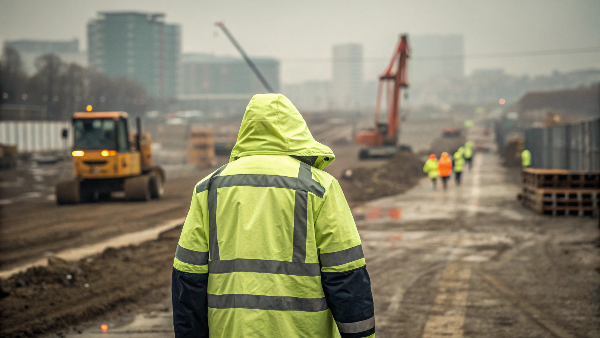
The way reflective jackets work is based on a fascinating optical principle called retro-reflection. It’s different from how a mirror reflects light or how a simple white surface scatters it. We at Vissafety rely on this science to create garments that significantly enhance wearer safety. The goal is to make the wearer as conspicuous as possible to anyone with a light source, like a driver at night. Understanding this mechanism helps appreciate why these jackets are so effective.
The Science of Retro-Reflection
The "magic" behind reflective jackets lies in the specialized materials used, typically in the form of tapes or treated fabrics.
- Incoming Light: Light from a source, such as car headlights, strikes the reflective material on the jacket.
- Retro-reflective Elements:
- Glass Beads: These are microscopic spherical beads. Light enters a bead, is refracted, reflects off the back surface of the bead (often coated with a reflective layer), and is refracted again as it exits, sending it back towards the source.
- Microprisms (Cube Corners): These are tiny, precisely angled structures (like the corner of a cube). Light entering a prism bounces off its three internal surfaces and is directed straight back out along its original path.
- Returned Light: A significant portion of the incoming light is returned directly to the light source. This means if you are a driver, your headlights illuminate the jacket, and that light is reflected straight back to your eyes.
Here’s a simplified comparison:
| Type of Reflection | Light Path | Observer's Perception (if observer is near light source) | Example |
|---|---|---|---|
| Diffuse Reflection | Light scatters in many directions. | Object appears moderately lit, not exceptionally bright. | White paper, matte wall |
| Specular Reflection | Light bounces off at an angle equal to the angle of incidence (like a ball). | Bright spot only if observer is at the correct angle. | Mirror, polished metal |
| Retro-reflection | Light is reflected directly back towards its source, regardless of entry angle. | Object appears intensely bright. | Reflective safety tape |
The efficiency of this retro-reflection is measured (e.g., by its RA value) and is a key factor in meeting safety standards like EN ISO 20471 and ANSI/ISEA 107. Our in-house lab, with over 75 testing devices, rigorously checks this performance. This ensures that when a driver's headlights hit one of our Vissafety jackets, the wearer is illuminated brightly, providing crucial seconds for the driver to react safely. It's simple physics put to life-saving use.
Conclusion
Reflective jackets enhance road safety by making people highly visible. They use special materials to bounce light back to drivers, preventing accidents in low light and saving lives.
-
Explore the advantages of reflective jackets to understand how they enhance safety and visibility in various environments. ↩
-
Learn how increased visibility can significantly reduce accidents and enhance safety for workers and pedestrians alike. ↩
-
Learn about the importance of high-visibility clothing in preventing accidents and ensuring safety in low-light conditions. ↩
-
Discover how PPE, including reflective jackets, plays a crucial role in workplace safety and accident prevention. ↩
-
Understanding retro-reflection can help you appreciate its role in safety gear, making it essential for visibility in low light conditions. ↩
-
Understanding the importance of visibility can help improve safety measures for all road users, especially vulnerable ones. ↩
-
Learn why visibility is crucial for rider safety and how it can prevent accidents on the road. ↩
-
Understanding the importance of wearing a reflective vest can significantly enhance your safety in various situations. Explore this link for detailed insights. ↩
-
Learn how visibility impacts safety in different environments and why it's crucial to be seen, especially near traffic. ↩

